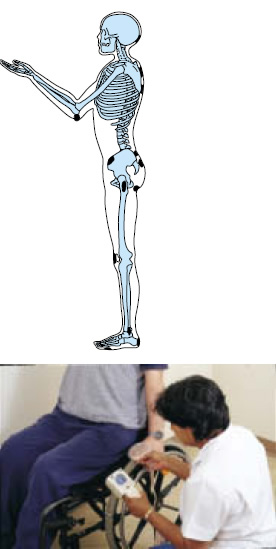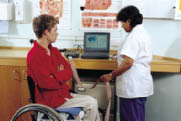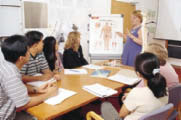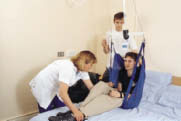Transfer of care from hospital to community
Discharge from hospital is a complicated process for both paraplegic and tetraplegic patients. Physical care is a major concern, and here the difference between levels of injury is profound. People with paraplegia usually become self caring; those with low tetraplegia, especially if young, may also achieve independence, but those with high tetraplegia may require help with their physical needs.
Achievement of good care depends largely on educating the patients, their families, and the community staff. Patients should be expert at understanding and, as far as possible, caring for their own bodies. They need to be able to recognise potential problems and either deal with them themselves or know where to seek advice. Much time is spent in teaching the importance of good skin, bladder and bowel care, as long-term problems in these areas are common.
People need to develop skills in:
- Understanding and caring for their own bodies
- Recognising potential problems
- Dealing with problems or learning where to go for advice
Education of patients
Skin care
Patients are taught how to use a mirror to check their pressure areas regularly, the stages of development of pressure sores, and what to do should a pressure mark occur. Wheelchairs and cushions are best assessed in a pressure clinic. If patients cannot lift themselves in their chair they need a cushion that allows them to sit in their wheelchair all day without resulting in a red mark on their skin. Weight, height, the degree of sensation and mobility, age, posture, motivation, and the quality of the skin all affect the type of cushion needed. All wheelchair cushions have a limited life and need regular checking to provide a reliable degree of assistance in prevention of sores.
Clothes made of natural fibres are preferable because many patients sweat excessively; clothing should not be tight otherwise there is risk of skin damage resulting in pressure sores. It should also be noted that hard seams and pockets which cross over the ischial tuberosities, trochanters, or coccyx may cause pressure marks on the skin. It is recommended that shoes should generally be one size larger than previously worn because of a tendency of the feet to swell during the day.
The choice of a suitable mattress is also important. Many pressure-relieving mattresses are now available, so all patients should be able to sleep for at least eight hours without being turned, and without resulting in a red mark on their skin. The patient should be assessed individually to ascertain the appropriate mattress for their long-term needs. Patients are encouraged to contact the pressure clinic for information and advice regarding any aspect of their care. In addition, the community liaison staff while visiting the patient in the community are able to reinforce educational aspects.
Bladder care
Patients are taught the most effective method of bladder emptying (see chapter 7). Although men with high tetraplegia can often tap over the bladder to induce a detrusor contraction, they may require help to apply a sheath and to fit a leg bag. In women with high tetraplegia the bladder is often best managed by a suprapubic catheter. It is best to avoid long-term urethral catheters as these may damage the bladder neck and urethra. Patients whose bladder emptying method involves an indwelling catheter are taught to regularly use a catheter valve (which can be opened and closed), to maintain bladder volume and compliance. Intermittent clean self- catheterisation is the preferred method for most women and men with paraplegia and some with low tetraplegia. It is particularly successful in patients with an acontractile bladder.
Long-term bladder management
Urinary tract infections are common but may be reduced by adequate hydration and often by urinary acidification. In general antibiotics are given only when an infection causes systemic symptoms. If recurrent urinary tract infections occur the patient should be investigated for underlying causes such as stones in the urinary tract or poor bladder emptying. Various surgical interventions are available in selected patients (see chapter 7).
Long-term bladder management:
- Intermittent self-catheterisation is preferred method for those with acontractile bladders
- Condom sheath drainage in contractile bladders
- If indwelling catheter, suprapubic catheter is preferable to urethral catheter, to avoid urethral damage. Use catheter valve to maintain bladder compliance and capacity
Urinary tract infections:
- Treat with antibiotics only if systemic symptoms present
- Adequate hydration and urinary acidification
- Investigate recurrent infections
Bowel care
Patients with tetraplegia and paraplegia who have an upper motor neurone cord lesion generally have reflex bowel activity, and evacuation can usually be produced by inserting glycerine suppositories or by anal digital stimulation, or both. Patients with high tetraplegia generally have poor balance and have to be hoisted on to a padded shower chair which can be wheeled over a toilet. This is more acceptable than being hoisted directly on to a toilet, which is generally less stable. In some circumstances bowel evacuation may need to take place on the bed with the patient in the left lateral position.
Bowel:
- Upper motor neurone cord lesion → reflex emptying — responds to suppositories and anal digital stimulation
- Lower motor neurone cord lesion → flaccid bowel with emptying by manual evacuation
Patients with low paraplegia and a lower motor neurone cord lesion generally have a flaccid bowel, so will need to evacuate their bowel manually or by straining using the abdominal muscles, or by a combination of the two methods. Patients who carry out manual evacuation are advised to keep their stools slightly constipated to ease removal. They should be able to transfer themselves onto a toilet, and the seat should be padded to prevent pressure sores from developing due to prolonged sitting. In practice most patients evacuate their bowels daily or on alternate days. When possible, the timing and frequency of bowel evacuation should be made to fit in with the person’s lifestyle. Help can be requested from the district nurse. Patients are advised to maintain their bowel regime and to avoid strong oral and rectal stimulant laxatives and enemas. Further educational principles are described in chapter 8 on nursing.
Long-term bowel management
A change in diet or lifestyle can affect bowel management, and patients are advised to change only one aspect of their bowel care at a time to minimise potential problems. Long-term options which can address chronic bowel management problems include colonic irrigation via the rectum, or through an abdominal stoma (an antegrade colonic enema), or a stoma, such as a colostomy.
Long-term bowel management:
- Daily or on alternate days
- Maintain consistent bowel regime
- Avoid strong laxatives and enemas
- Should fit in with patient’s lifestyle
- Change in diet or lifestyle can affect bowel management
- Only change one aspect of bowel care at a time, to minimise potential problems
Autonomic dysreflexia
Autonomic dysreflexia is commonly associated with bladder or bowel problems, particularly overdistension. By the time of discharge from hospital, patients should be fully aware of the signs and symptoms of autonomic dysreflexia and be able to direct people to help find and remove the cause (see chapter 6).
Autonomic dysreflexia. High lesion patients must:
- be aware of the signs and symptoms
- be able to direct care.
Nutrition
Patients with spinal cord injury, particularly those with high lesions, are often unable to exercise adequately and are prone to excessive weight gain, which can further limit their mobility and independence. In the long term, most patients tend to be constipated and will benefit from dietary re-education. A diet of good nutritional standard but with a controlled calorific content is important. Care needs to be taken in changing the diet if constipation, or more seriously diarrhoea with a risk of bowel accidents, is to be avoided.
Nutrition:
- Prone to excessive weight gain
- Diet of good nutritional standard, to include 5 servings of fruit and vegetables per day
- Change of diet affects bowel management
Teaching the family and community staff
When patients are discharged from hospital they should be thoroughly responsible for their own care. If the patient wishes, family members are given individual instruction on how to help in their care and have the opportunity to attend a study day about all aspects of spinal cord injury. If it is envisaged that the patient will require help in the community, district nurses and carers are invited to the spinal unit to work with the primary care teams, thereby enabling them to learn specific aspects of care for their prospective patients. The community staff can also be invited to attend study days which include the subjects of pressure sore prevention, bladder and bowel management, activities of daily living, long-term aspects of spinal cord injury, and psychological support. Most community staff welcome the opportunity to visit the spinal unit as spinal cord injury is not very common.
The community liaison staff based at the spinal unit will also visit community staff to give support and advice.
Preparation for discharge from hospital
Providers of care
Patients with high tetraplegia require a substantial amount of care, which will be given by other people. Traditionally this care has been provided by the patient’s family. The family should not be expected to take responsibility for the delivery of care, however, especially as it will be required for many years, and they may already have work commitments that are financially necessary. Usually, people with a high level of disability wish to maintain their independence as much as possible and so choose to live independently, therefore it is essential that they have help to do this. The patient may require the services of district nurses and local care agencies. With financial support the patient may be able to employ their own care such as a live-in carer or personal assistant.
Independent living becomes an achievable goal for the patient with the utilisation of these support services. If help and support are not given when the patient goes home from hospital this can increase pressure on the family unit and lead to the breakdown of relationships. Even if the family members are not providing the physical care it is important that they have their own space and time otherwise resentment can occur along with physical and emotional exhaustion.
Providers of care:
- District nurses
- Care assistants
- Resident carers/personal assistants:
- Privately employed
- Employed by disabled person using state benefits
- Family
Planning for discharge home
Preparation for discharge home should start soon after the patient is admitted to a spinal unit. Many patients with a spinal cord injury are young and were already making decisions about their future. It is very difficult for them to make major choices of where to live and with whom and to decide who may be able to help them with their care. It is sometimes necessary to have a temporary solution, and when they have had more time to adjust to their injury a more permanent solution can be found. It is therefore essential that this initial decision should allow a certain amount of flexibility.
Planning for discharge home:
- Commence plans for discharge as early as possible
- Major decisions to make regarding future plans
- May need temporary solution
- Flexible thinking for planning discharge
Planning for independent living
Many patients with tetraplegia choose to live independently, and initially statutory care facilities in the patient’s home may be used. These services may not be able to meet fully the care needs of someone with a high level of injury so they may need to be supplemented. Many people will prefer to employ a personal assistant to live in to help with personal care and daily living activities. This allows people to take control of their lives but requires them to develop skills in interviewing, financial management, and teaching. When financial compensation for the injury is not available staff from the spinal unit contact the patient’s local social services and health care trusts for financial support through community care assessment, the Independent Living Fund (ILF), and direct payment scheme. Initially, patients choosing this option often require additional support from the spinal unit for advice in relation to, for instance, advertising for carers and interviewing. Patients quickly become totally responsible for their own care on leaving the spinal unit.
Aim for independent living:
- To become totally responsible for their own care on discharge from spinal unit
Skills required for independent living:
- Interviewing, employing and training staff
- Managing personal finances
- Effective communication skills (assertiveness, telephone skills)
Planning for interim care
When their homes have not been adapted for wheelchair use before the patients’ discharge from the spinal unit, interim care may be necessary and can help to act as a bridge between the protection of a spinal injuries unit and the reality of everyday living with a disability.
Planning for interim care. Acts as a bridge between:
- protection of a spinal injuries unit
- reality of everyday living with a disability
Easing transfer from hospital to community
The support of the district nursing service is invaluable in easing the transfer from the spinal unit to the community. Before discharge patients will have some weekends at home. Difficulties experienced by them and their families can be discussed with the district nurse and care agency, who can assess the situation and contact the spinal unit if advice is required. The families are often reassured to know that there is an effective link between the spinal unit and the community. To maintain this link the initial discharge plan may require a district nurse each morning to provide personal care with help from a care assistant.
Transfer from hospital to community eased by:
- Single and joint visits from:
- District nurse (once a day initially)
- Care assistant
- Community liaison staff from spinal unit (within 6–8 weeks after discharge from hospital, thereafter on request)
The early weeks at home
The early weeks after discharge can be both physically and emotionally exhausting for all concerned. The patients are faced with the harsh reality of everyday living. However well a patient’s community care is planned, problems may still arise. For this reason all patients are visited by the community liaison staff from the spinal unit usually within 6–8 weeks of discharge and at other times as required at the request of the patient, family, carers, district nurse, or general practitioner. Community liaison staff will meet with community staff and visit patients together to educate and further ease the transfer of care from the spinal unit to home.
Travel and holidays
When considering travelling and holidays it is important that this is well planned to ensure there is no risk to the patient’s health. There are a few specific areas that will need to be addressed.
| Skin care | If there is some uncertainty about the condition of the mattress the patient will be sleeping on while away from home, it is wise for the patient to take an overlay mattress in the luggage. |
| Bladder care | If the patient normally manages his/her bladder by intermittent self-catheterisation and is going on a long journey, such as a long flight, it may be more practicable to have an indwelling urethral catheter for the duration of the flight, due to difficult access to toilet facilities. If the patient is travelling to a hot country fluid intake should be increased and catheters adjusted accordingly. |
| Bowel care | Different food, particularly spicy dishes, may affect a patient’s bowel habit. Patients are advised to adjust their bowel regime accordingly, and are taught how to carry out bowel care on a bed, should toilets be inaccessible. |
| Cushions | When travelling on a plane, patients are advised to keep their cushions with them and not to allow them to be stored in the hold with the wheelchair, as they can easily get lost. It may be necessary for patients to sit on their cushions whilst on a plane to aid pressure relief, particularly on long journeys. Patients should seek advice from their spinal unit, or an association such as the Spinal Injuries Association, prior to travelling. |
Travel and holidays:
- Plan well ahead
- Ascertain condition of mattress — use an overlay
- Air flights
- indwelling urethral catheter may be needed
- keep wheelchair cushion during flight and sit on it if possible
- Increase fluid intake in hot climates
- Spicy food may affect bowel management
- Bowel care may need to be carried out on a bed Seek advice from the spinal unit prior to travelling abroad
Follow-up
Patients are followed up as outpatients by their spinal unit. This consists of regular outpatient appointments, which normally include a yearly renal ultrasound and abdominal x ray. During these appointments it is important that the patient has access to a multidisciplinary team who can provide ongoing assessment of the patient’s health care needs, and minimise the incidence of potential problems. It is also important that patients have access to telephone advice and community visits from a spinal unit, and that they are aware of information resources available to them, such as the Spinal Injuries Association.
Follow-up:
- Regular outpatient clinic appointments
- Regular renal ultrasound and abdominal x ray
- Access to a multidisciplinary team
- Telephone support and advice from spinal unit
- Information resources — Spinal Injuries Association
See also
- At the accident:
- History and epidemiology of spinal cord injury
- Spinal injuries management at the scene of the accident
- Evacuation and initial management at hospital:
- Evacuation and transfer to hospital of patients with spinal cord injuries
- Initial management of patients with spinal cord injuries at the receiving hospital
- Neurological assessment of patients with spinal cord injuries
- Spinal shock after severe spinal cord injury
- Partial spinal cord injury syndromes
- Radiological investigations:
- Initial radiography of patients with spinal cord injuries
- Cervical injuries
- Thoracic and lumbar injuries
- Early management and complications of spinal cord injuries — I:
- Respiratory complications
- Cardiovascular complications
- Prophylaxis against thromboembolism
- Initial bladder management
- The gastrointestinal tract
- Use of steroids and antibiotics
- The skin and pressure areas
- Care of the joints and limbs
- Later analgesia
- Trauma re-evaluation
- Early management and complications of spinal cord injuries — II:
- The anatomy of spinal cord injury
- The spinal injury (cervical, thoracic and lumbar spine)
- Transfer to a spinal injuries unit
- Medical management in the spinal injuries unit:
- The cervical spine injuries
- The cervicothoracic junction injuries
- Thoracic injuries
- Thoracolumbar and lumbar injuries
- Deep vein thrombosis and pulmonary embolism
- Autonomic dysreflexia
- Biochemical disturbances
- Para-articular heterotopic ossification
- Spasticity
- Contractures
- Pressure sores
- Urological management of patients with spinal cord injury:
- Nursing for people with spinal cord lesion:
- Physiotherapy after spinal cord injury:
- Respiratory management
- Mobilisation into a wheelchair
- Rehabilitation
- Recreation
- Incomplete lesions
- Children
- Occupational therapy after spinal cord injury:
- Hand and upper limb management
- Home resettlement
- Activities of daily living
- Communication
- Mobility
- Leisure
- Work
- Social needs of patient and family:
- Transfer of care from hospital to community:
- Education of patients
- Teaching the family and community staff
- Preparation for discharge from hospital
- Easing transfer from hospital to community
- Travel and holidays
- Follow-up
- Later management and complications after spinal cord injury — I:
- Late spinal instability and spinal deformity
- Pathological fractures
- Post-traumatic syringomyelia (syrinx, cystic myelopathy)
- Pain
- Sexual function
- Later management and complications after spinal cord injury — II:
- Later respiratory management of high tetraplegia
- Psychological factors
- The hand in tetraplegia
- Functional electrical stimulation
- Ageing with spinal cord injury
- Prognosis
- Spinal cord injury in the developing world:








